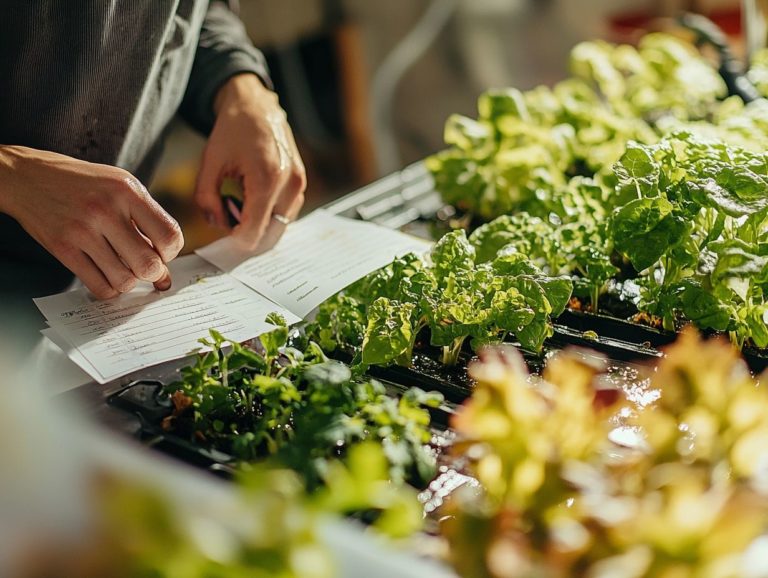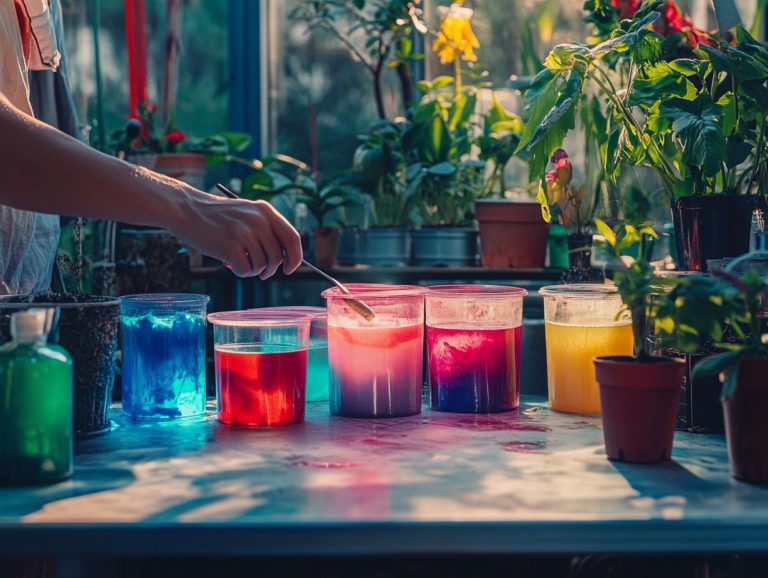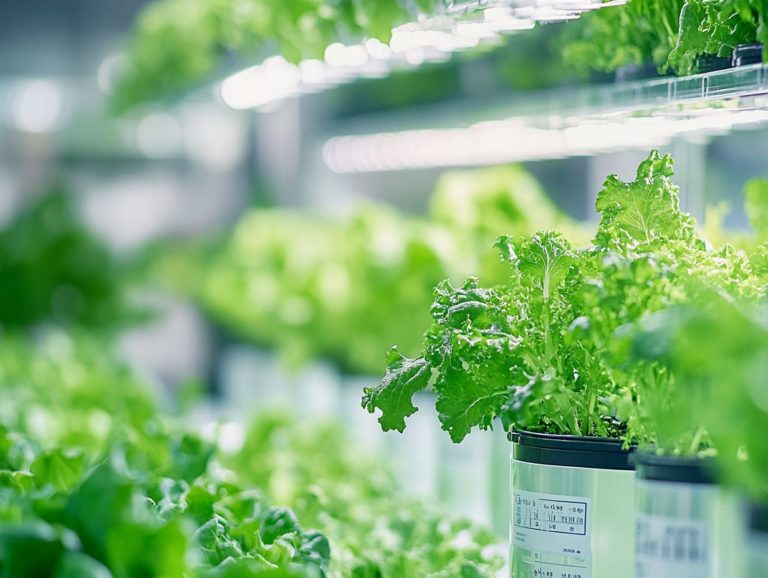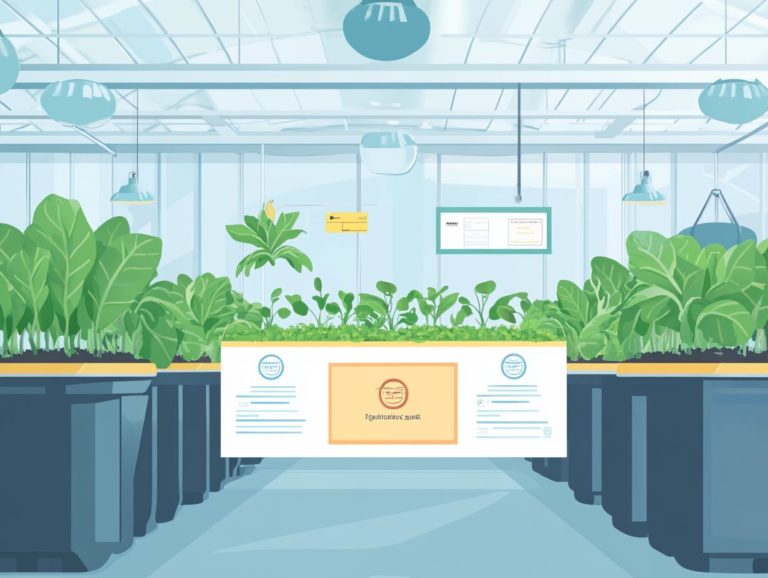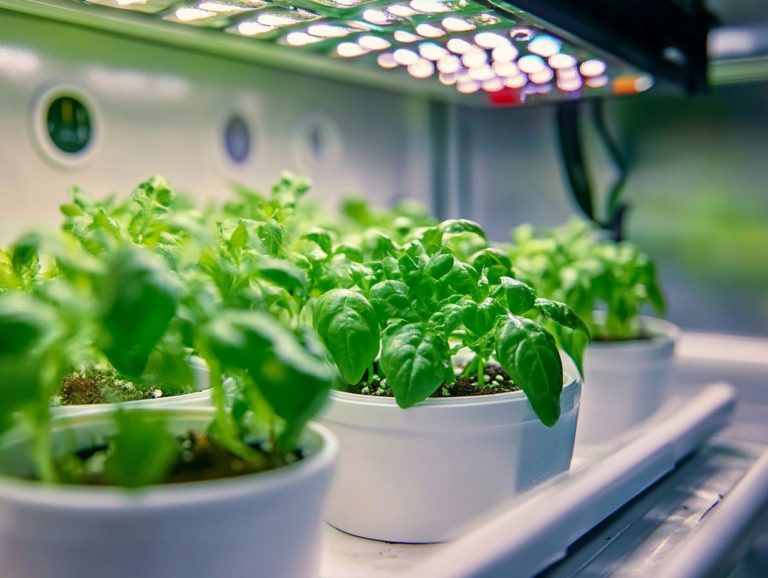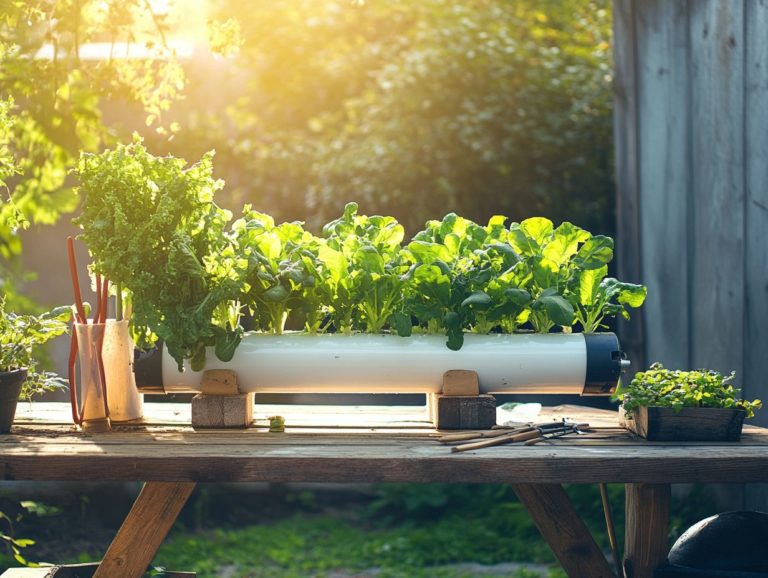What are the Benefits of Hydroponic Gardening?
Hydroponic gardening is revolutionizing how you grow plants by presenting a soil-less approach that optimizes both efficiency and sustainability through the use of water with added nutrients.
With advantages such as faster growth rates, higher yields, lower water usage, and the opportunity to garden all year round, imagine enjoying fresh veggies regardless of the season!
This article explores the various types of hydroponic systems, offers essential tips for getting started, and helps troubleshoot common challenges related to growing conditions.
Whether you re just starting or you re a seasoned pro, there s something here for everyone eager to nurture their green thumb, including insights on urban farming techniques.
Contents
- Key Takeaways:
- Advantages of Hydroponic Gardening
- Types of Hydroponic Systems
- Getting Started with Hydroponic Gardening
- Troubleshooting Common Issues
- Frequently Asked Questions
- What are the Benefits of Hydroponic Gardening?
- How does Hydroponic Gardening benefit the environment?
- What are the health benefits of Hydroponic Gardening?
- Can Hydroponic Gardening be done year-round?
- What are the Economic Benefits of Hydroponic Gardening?
- Are There Benefits for Urban Areas with Limited Space?
Key Takeaways:
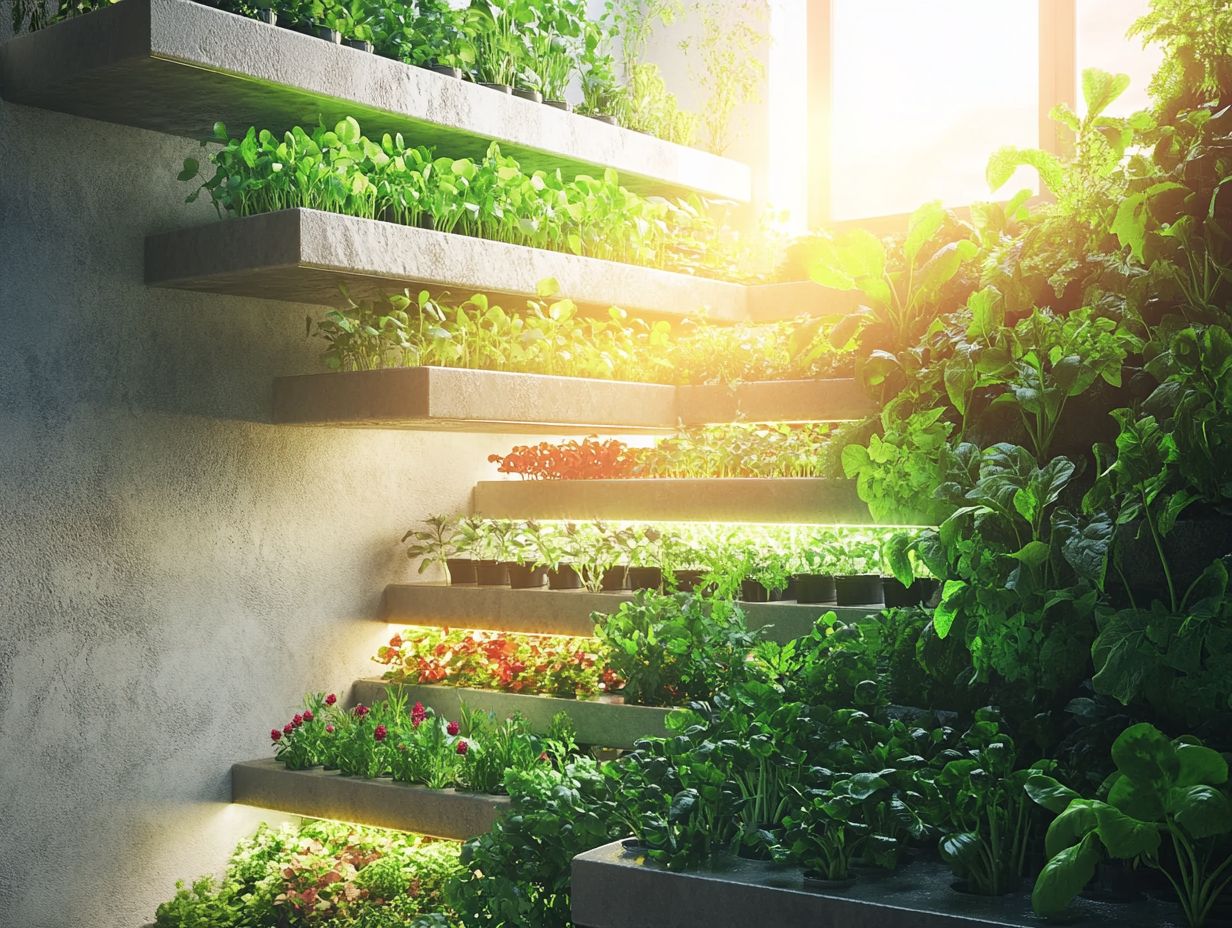
- Hydroponic gardening leads to increased growth and yield of plants.
- This method conserves water, using only a fraction needed for soil gardening.
- Enjoy fresh produce year-round, regardless of weather or location.
What is Hydroponic Gardening?
Hydroponic gardening is a groundbreaking agricultural practice that allows you to grow plants in a controlled environment, using water with added nutrients instead of traditional soil. This method enhances nutrient absorption and minimizes soil degradation, gaining popularity in urban settings to boost local food production.
By creating small environments that are perfect for growing plants, hydroponics ensures optimal growing conditions for various crops. This makes it a sustainable solution to tackle pressing issues like climate change and food shortages, contributing to sustainable agriculture. To learn more about the advantages, check out the benefits of hydroponics vs. traditional gardening.
In essence, hydroponic systems provide notable advantages over conventional farming methods by delivering essential nutrients directly to plants. This results in faster growth and higher yields. Techniques like using coconut coir as a growing medium optimize water retention and create an ideal environment for strong root development. To learn more about the environmental benefits, check out the impact of hydroponics on the environment.
Urban farming initiatives increasingly embrace this sustainable method, not only to reduce transportation emissions but also to cultivate local food systems enhancing community resilience through efficient farming methods. By integrating hydroponic gardening into food production frameworks, cities can tackle challenges posed by limited space and dwindling arable land, paving the way for a more sustainable agricultural future.
Advantages of Hydroponic Gardening
Hydroponic gardening offers a range of advantages, making it an excellent choice for modern agricultural practices. This innovative method not only boosts crop yields but also promotes substantial water conservation, essential for addressing resource depletion.
By embracing hydroponics, you can help local farmers produce more food safely while achieving higher crop yields through better nutrient absorption.
Increased Growth and Yield
One of the standout benefits of hydroponic gardening is the significant increase in plant growth and yield. This is achieved through optimized nutrient absorption and carefully controlled growing conditions that encourage rapid development.
This advanced cultivation method uses various techniques, such as the nutrient film technique (NFT) and aeroponics, where a thin film of nutrient-rich water flows over the roots, delivering essential minerals and oxygen directly. Using energy-efficient LED lighting mimics sunlight and reduces energy costs while providing the specific wavelengths necessary for photosynthesis.
All these elements come together to create shorter growth cycles, with the potential for faster growth and significantly higher crop yields compared to traditional farming methods. Hydroponic systems are a compelling solution to meet the growing demand for food worldwide.
Start your hydroponic garden today and enjoy fresh produce at home!
Reduced Water Usage
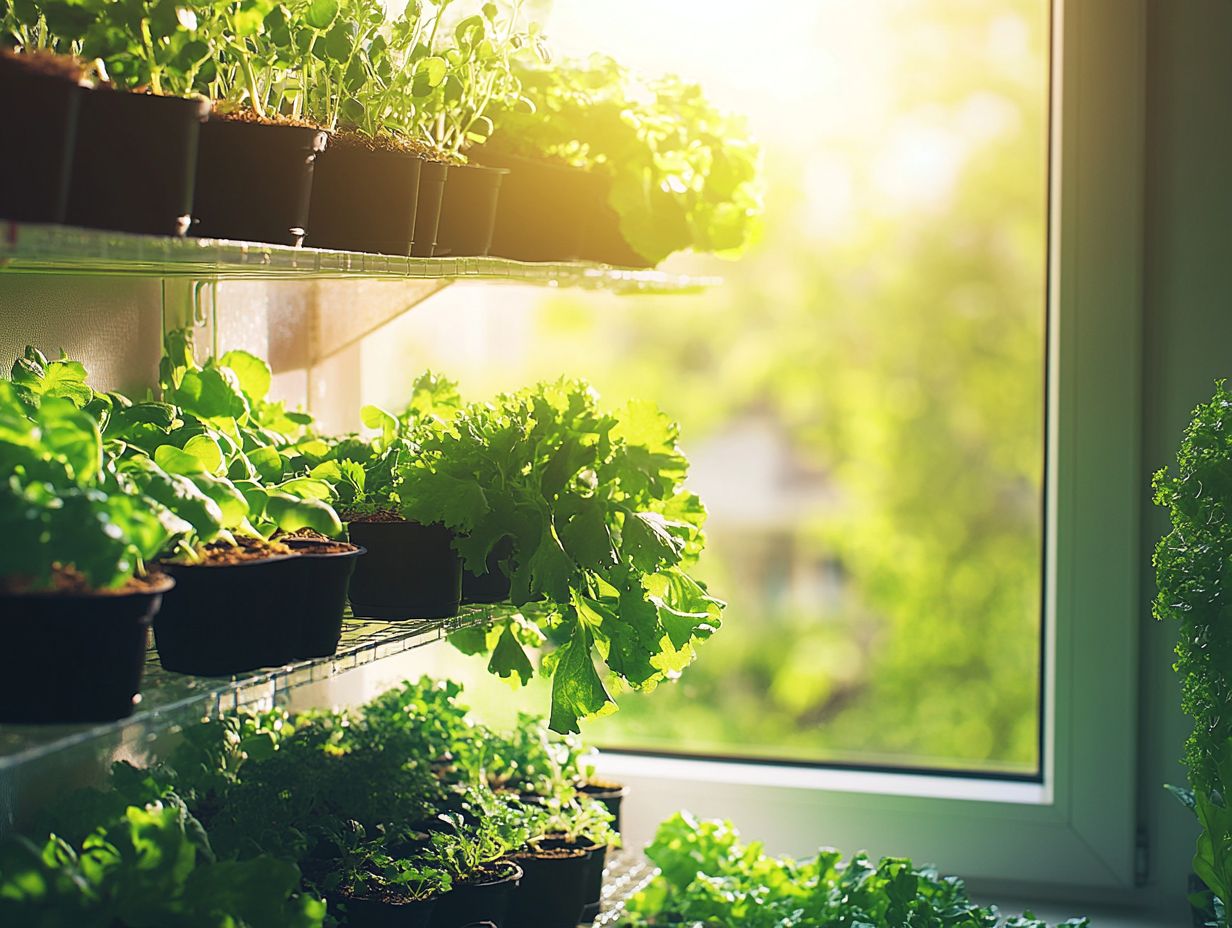
Hydroponic gardening stands out for its remarkable ability to significantly reduce water usage compared to traditional soil farming. This makes it an essential ally in the pursuit of water conservation and the fight against resource depletion.
This innovative approach employs systems like nutrient film technique, a method where a thin film of nutrient-rich water is used to nourish plants, and vertical farming, which delivers essential nutrients while minimizing waste.
By adopting hydroponics, you can achieve higher yields and play a vital role in preserving precious freshwater resources. Your efforts contribute to enhanced water conservation. The implications are profound; healthier water sources benefit ecosystems, and you gain the power to cultivate crops in areas where water is scarce. However, it’s important to be aware of the common hydroponic gardening myths that may affect your understanding of this innovative practice.
As you embrace these efficient farming techniques, you contribute to a more sustainable agricultural landscape that values both environmental health and economic viability, which are integral to **sustainable agriculture** practices.
Year-Round Gardening
With hydroponic gardening, year-round gardening becomes entirely achievable. Growing plants indoors under controlled conditions allows for the consistent production of fresh produce, regardless of seasonal changes.
This innovative approach guarantees a stable food supply by enabling continuous crop growth and reduces reliance on traditional farming methods that often hinge on seasonal cycles. By exercising precise control over conditions such as temperature, humidity, and light, crop growth efficiency is enhanced while dramatically cutting down on water usage.
These systems also contribute to lower greenhouse gas emissions, as they require significantly less transportation compared to conventional agriculture, thus supporting **environmental benefits**. However, it’s important to be aware of the disadvantages of hydroponic gardening. You will dramatically reduce your environmental impact by adopting hydroponics and similar techniques, paving the way for a more sustainable future.
Types of Hydroponic Systems
You ll discover a diverse array of hydroponic systems, each meticulously crafted to enhance plant growth through cutting-edge agricultural technologies. These include aeroponics and the nutrient film technique, vital for improving **crop production**.
Comparison and Benefits of Different Systems
Comparing different hydroponic systems unveils unique benefits, from enhanced crop production to improved pest control and disease prevention strategies. This demonstrates the **agricultural innovation** at play.
Take a look at systems like deep water culture and vertical farming; each has its own set of advantages and challenges in crop cultivation. For example, with deep water culture, roots bask in nutrient-rich water, leading to impressively **faster growth** rates. Vertical farming optimizes space usage, making it a superb choice for urban environments, though it may come with higher energy demands. To explore more about innovative methods like hydroponics, check out what is hydroponic gardening in a greenhouse?
Both systems incorporate innovative pest management techniques, often favoring integrated pest management to reduce chemical reliance.
By thoughtfully analyzing these methods, you can appreciate how hydroponics not only transforms agriculture but also tackles pressing sustainability issues in food production today.
Getting Started with Hydroponic Gardening
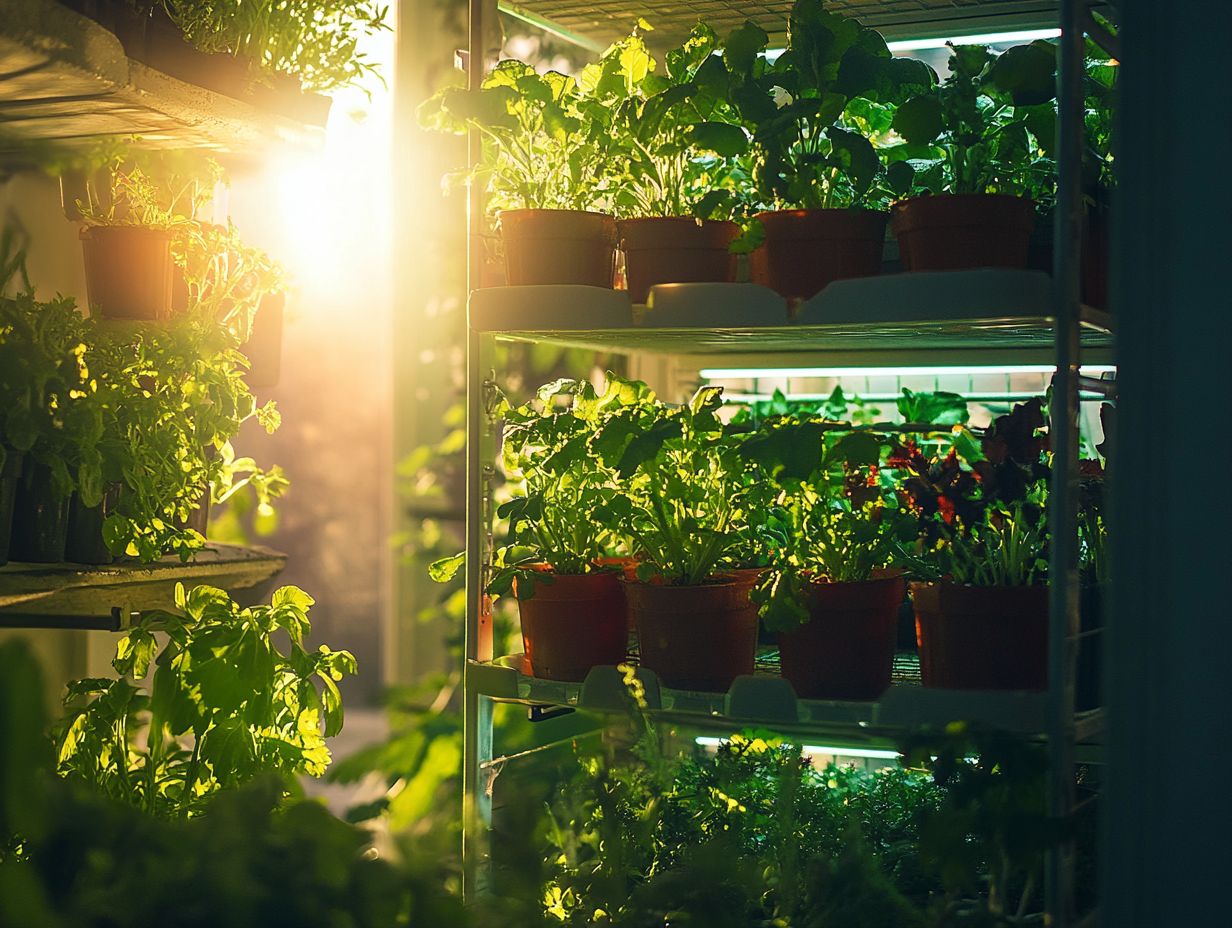
Embarking on your hydroponic gardening journey demands careful consideration in selecting essential supplies and meticulously planning your setup. This thoughtful approach will significantly enhance the success of your chosen hydroponic systems.
We encourage you to explore hydroponics and experience its benefits firsthand.
Essential Supplies and Setup
Essential supplies for your hydroponic gardening journey include a variety of hydroponic systems, nutrient-filled water solutions, and efficient LED lighting that mimics artificial light to optimize the growth of your fresh produce. Each of these components plays a critical role in establishing a thriving environment for your plants.
To get started, consider the range of hydroponic systems available from simple wick systems to more intricate deep water culture setups. Each system is designed to efficiently deliver nutrients and oxygen directly to the roots, ensuring your plants receive exactly what they need. Pumps are essential in this setup, circulating water and nutrients throughout the system to guarantee that every plant enjoys adequate hydration and nourishment.
The right nutrient solution is also key; it should be specifically formulated for hydroponics to provide the essential minerals and vitamins that foster vigorous growth and ensure food quality. If you’re curious about the fundamentals, you can learn more about what hydroponic gardening is. By combining these supplies, you’ll create an ideal setup that maximizes yield while minimizing space and resource consumption.
Troubleshooting Common Issues
Troubleshooting common issues in hydroponic gardening requires you to identify problems early and address them efficiently, focusing on optimizing nutrient absorption. By doing so, you can prevent potential diseases and set the stage for a flourishing garden.
Identifying and Addressing Problems
Identifying and addressing issues in hydroponic systems is essential for maintaining high crop yields that are free from pests and disease, reinforcing the importance of pest control strategies.
To achieve this, you should employ a variety of monitoring techniques, including regular pH and EC testing (Electrical Conductivity testing, which measures nutrient levels in water) to assess nutrient levels. Be vigilant for visual cues, such as yellowing leaves or stunted growth, which often signal nutrient deficiencies like nitrogen or magnesium shortfalls that impede crop cycle efficiency.
Implementing integrated pest management (IPM) strategies such as introducing beneficial insects or using organic insecticides can significantly diminish pest populations. Equally important is establishing a routine for inspecting your plants for early signs of disease, such as mold or mildew, and maintaining optimal environmental conditions to prevent outbreaks.
By combining these practices, you can cultivate a robust hydroponic ecosystem that thrives with minimal disturbances.
Frequently Asked Questions
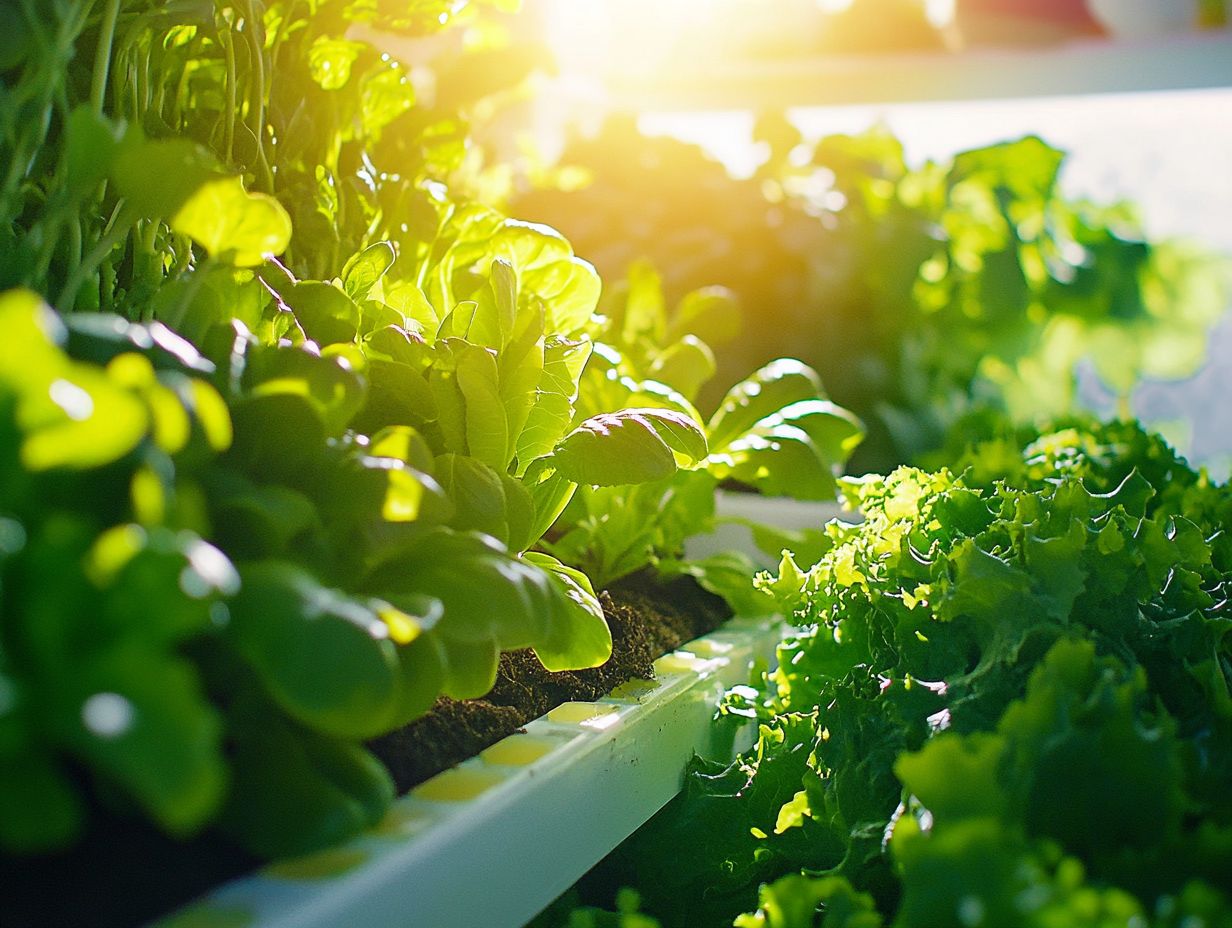
What are the Benefits of Hydroponic Gardening?
Imagine growing lush plants without soil! That’s the magic of hydroponic gardening. This innovative technique offers numerous benefits, including resource depletion reduction and waste reduction through efficient farming practices.
How does Hydroponic Gardening benefit the environment?
Since hydroponic gardening does not require soil, it eliminates the need for chemical pesticides and fertilizers that can harm the environment. It also conserves water and reduces waste by recycling nutrient solutions.
What are the health benefits of Hydroponic Gardening?
Hydroponically grown plants are generally healthier and more nutritious as they are free from soil-borne diseases and pests. This also means there is no need for harmful chemicals, making the produce safer for consumption. The use of coconut coir as a growing medium further enhances nutrient absorption, ensuring optimal health for the plants.
Can Hydroponic Gardening be done year-round?
Yes! One of the biggest benefits of hydroponic gardening is that it can be done year-round, regardless of climate or season. This is largely due to the ability to create a controlled environment for the plants to thrive in, utilizing technologies such as LED lighting to support faster growth and ensure effective pest control.
Don t wait to start your hydroponic journey! The benefits of hydroponic gardening are just a few steps away. Ready to grow your own fresh produce? Dive into hydroponic gardening today!
What are the Economic Benefits of Hydroponic Gardening?
Hydroponic gardening is a cost-effective option. It needs less space and uses less water than traditional gardening.
This method also produces higher yields. This means it can be a profitable choice for both farmers and home gardeners.
Are There Benefits for Urban Areas with Limited Space?
Hydroponic gardening thrives in urban areas. You can grow plants in small spaces like balconies, rooftops, and even indoors.
This approach allows city dwellers to enjoy fresh produce without needing a large garden. Local farmers can also take part by providing fresh food to their communities.

